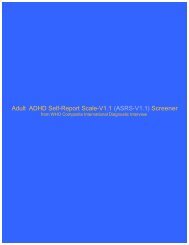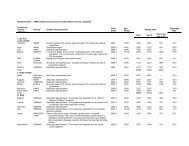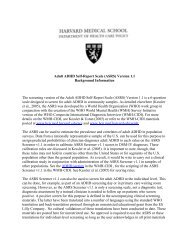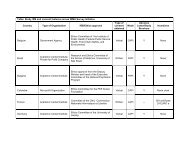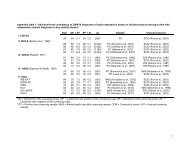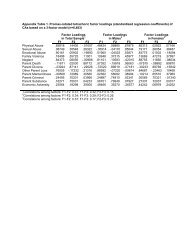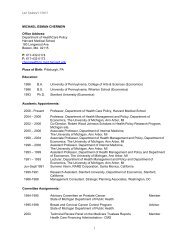Model Quality Report in Business Statistics - Harvard ...
Model Quality Report in Business Statistics - Harvard ...
Model Quality Report in Business Statistics - Harvard ...
You also want an ePaper? Increase the reach of your titles
YUMPU automatically turns print PDFs into web optimized ePapers that Google loves.
3 Simulation study of alternative variance estimation<br />
methods<br />
Paul Smith, Susan Full & Ceri Underwood, Office for National <strong>Statistics</strong><br />
Ray Chambers & David Holmes, University of Southampton<br />
The tender suggested a simulation study of the variance estimation methods available <strong>in</strong> the<br />
software, to assess the properties of the variance estimators – bias, coverage, variability,<br />
relation to the size of the estimate. As a bonus this has the effect of demonstrat<strong>in</strong>g that the<br />
various software packages do or do not produce the same solutions with the same model<br />
formulation and the same <strong>in</strong>put data, as reported <strong>in</strong> section 2.2.7. The comb<strong>in</strong>ations of<br />
features (estimation method and variance calculation approach) which are available <strong>in</strong> the<br />
software considered are shown <strong>in</strong> Table 3.1.<br />
Taylor<br />
Number raised estimation CLAN, GES, STATA,<br />
SUDAAN<br />
Jackknife<br />
GES, SUDAAN<br />
Ratio estimation CLAN, GES, STATA*,<br />
SUDAAN* + GES, SUDAAN* +<br />
Regression estimation CLAN, GES GES<br />
Constra<strong>in</strong>ed-weight<br />
regression estimation<br />
STATA*<br />
Table 3.1 Comb<strong>in</strong>ations of estimators and variance estimation techniques used <strong>in</strong> the<br />
simulation study, with the packages which have been used. * variance estimation uses weights <strong>in</strong> a<br />
manner which is not strictly valid (see section 2.2.4); + valid variances can be produced but only by us<strong>in</strong>g the<br />
software <strong>in</strong> a non-standard way (see section 2.2.4).<br />
The simulation process has turned out to be a long one, and not all of the results obta<strong>in</strong>ed are<br />
presented here; <strong>in</strong>stead we concentrate on the ma<strong>in</strong> messages to have emerged. Some of the<br />
results presented here seem to lack <strong>in</strong>ternal consistency, and on the whole it seems that the<br />
whole area will benefit from further detailed study <strong>in</strong> the future. It is hoped that the study will<br />
cont<strong>in</strong>ue past the end of the present contract.<br />
3.1 The simulated population<br />
3.1.1 A model for data generation<br />
For the purposes of the simulation study, data were taken from the UK’s Annual Bus<strong>in</strong>ess<br />
Inquiry (ABI), which is a sample survey, cross-stratified by 5-digit <strong>in</strong>dustries of the SIC(92)<br />
(approximately four-digit NACE classes but slightly more detailed <strong>in</strong> places) and<br />
employment size (more detailed <strong>in</strong>formation on this survey is conta<strong>in</strong>ed <strong>in</strong> the <strong>Model</strong> <strong>Quality</strong><br />
<strong>Report</strong>, volume III chapter 3). The <strong>in</strong>formation on employment comes from the Inter-<br />
Departmental Bus<strong>in</strong>ess Register (IDBR) (Perry 1995), the UK’s frame for bus<strong>in</strong>ess surveys.<br />
The survey data have been used to fit a model of the form<br />
24



